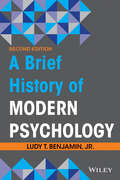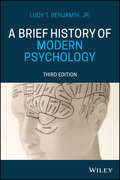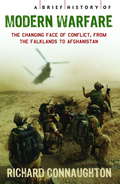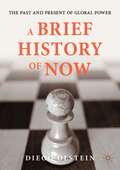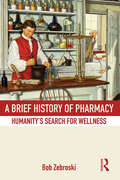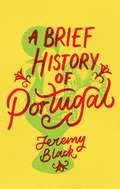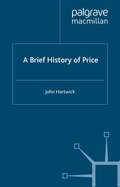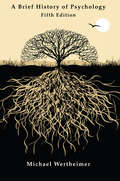- Table View
- List View
A Brief History of Mathematics: A Promenade through the Civilizations of Our World
by Tianxin CaiThis volume, originally published in China and translated into four other languages, presents a fascinating and unique account of the history of mathematics, divided into eight chronologically organized chapters. Tracing the development of mathematics across disparate regions and peoples, with particular emphasis on the relationship between mathematics and civilization, it examines mathematical sources and inspirations leading from Egypt, Babylon and ancient Greece and expanding to include Chinese, Indian and Arabic mathematics, the European Renaissance and the French revolution up through the Nineteenth and Twentieth Centuries. Each chapter explores connections among mathematics and cultural elements of the time and place treated, accompanying the reader in a varied and exciting journey through human civilizations. The book contemplates the intersections of mathematics with other disciplines, including the relationship between modern mathematics and modern art, and the resulting applications, with the aid of images and photographs, often taken by the author, which further enhance the enjoyment for the reader. Written for a general audience, this book will be of interest to anyone who's studied mathematics in university or even high school, while also benefiting researchers in mathematics and the humanities.
A Brief History of Mechanical Engineering (Materials Forming, Machining and Tribology)
by Uday Shanker Dixit Manjuri Hazarika J. Paulo DavimWhat is mechanical engineering? What a mechanical engineering does? How did the mechanical engineering change through ages? What is the future of mechanical engineering? This book answers these questions in a lucid manner. It also provides a brief chronological history of landmark events and answers questions such as: When was steam engine invented? Where was first CNC machine developed? When did the era of additive manufacturing start? When did the marriage of mechanical and electronics give birth to discipline of mechatronics? This book informs and create interest on mechanical engineering in the general public and particular in students. It also helps to sensitize the engineering fraternity about the historical aspects of engineering. At the same time, it provides a common sense knowledge of mechanical engineering in a handy manner.
A Brief History of Modern India - Competitive Exam
by Rajiv AhirThis book brings together various aspects of the turbulent period (from arrival of the Europeans on Indian soil and the establishment of British rule in India to the day India won independence and the early years of freedom) in a systematic and succinct manner: major and important details and milestones are effectively discussed while several relevant but little known details are also highlighted. It is not just the mainstream freedom struggle that has been considered; the disparate efforts—small but significant— of several groups have also been discussed. The political and socio-economic developments that have influenced the growth of modern India have been dealt with in independent chapters.
A Brief History of Modern Psychology
by Ludy T. Benjamin Jr.In A Brief History of Modern Psychology 2nd Edition, Ludy Benjamin, a leading historian in the field, discusses the history of both the science and the practice of psychology since the establishment of the first experimental psychology laboratory in 1879. In engaging prose, this book weaves together the historical and disciplinary context that will help readers to better understand the richness and complexity of contemporary psychology. In the Second Edition, personality, social, and developmental psychology are expanded upon, providing balanced coverage of these three topics.
A Brief History of Modern Psychology: An Easy Guide To Music Notation - Third Edition (Let's Go Third Edition Ser.)
by Ludy T. Benjamin Jr.A Brief History of Modern Psychology offers a concise account of the evolution of this dynamic field—from early pioneers of psychological theory to cutting-edge contemporary applications. In this revised third edition, leading scholar Ludy Benjamin surveys the significant figures, concepts, and schools of thought that have shaped modern psychology. Engaging and accessible narrative provides readers historical and disciplinary context to modern psychology and encourages further investigation of the topics and individuals presented. This book provides a solid foundational knowledge of psychology’s past, covering essential areas including prescientific psychology, physiology and psychophysics, early schools of German and American psychology, and the origins of applied psychology, behaviorism, and psychoanalysis. Exploration of 20th century and contemporary developments, including the emergence of clinical and cognitive psychology, ensures a complete overview of the field. The author integrates biographical information on widely recognized innovators such as Carl Jung, Wilhelm Wundt, and B.F. Skinner with lesser known figures including E.B. Titchener, Mary Calkins, and Leta Hollingworth. This personalistic approach to history allows readers to understand the theories, research, and practices of the individuals who laid the foundation to modern psychology.
A Brief History of Modern Psychology
by Ludy T. Benjamin Jr.A Brief History of Modern Psychology offers a concise account of the evolution of this dynamic field—from early pioneers of psychological theory to cutting-edge contemporary applications. In this revised third edition, leading scholar Ludy Benjamin surveys the significant figures, concepts, and schools of thought that have shaped modern psychology. Engaging and accessible narrative provides readers historical and disciplinary context to modern psychology and encourages further investigation of the topics and individuals presented. This book provides a solid foundational knowledge of psychology’s past, covering essential areas including prescientific psychology, physiology and psychophysics, early schools of German and American psychology, and the origins of applied psychology, behaviorism, and psychoanalysis. Exploration of 20th century and contemporary developments, including the emergence of clinical and cognitive psychology, ensures a complete overview of the field. The author integrates biographical information on widely recognized innovators such as Carl Jung, Wilhelm Wundt, and B.F. Skinner with lesser known figures including E.B. Titchener, Mary Calkins, and Leta Hollingworth. This personalistic approach to history allows readers to understand the theories, research, and practices of the individuals who laid the foundation to modern psychology.
A Brief History of Modern Warfare: The changing face of conflict, from the Falklands to Afghanistan (Brief Histories)
by Richard ConnaughtonSince Vietnam, both the way we fight and our reasons for going to war have become much more complex.The importance of a conflict is determined not by its size or by the numbers of combatants involved but by its ripple effects and its influence upon future events. In a series of thrilling recreations of eight of the most significant encounters of the last three decades, military historian Richard Connaughton presents a fascinating insight into modern warfare, including interviews with some of the major figures. The conflicts include Goose Green in the Falklands, the invasion of Grenada, Operation Desert Storm - the first Iraq War, Operations in Mogadishu as immortalized in the book and film Blackhawk Down, the Siege of Gorazde and Operation Barras in Sierra Leone, as well as more recent events at Fallujah, Iraq, and in Helmand Province, Afghanistan. Richard Connaughton has interviewed most of the major figures involved in each of the conflicts and offers powerful insights into why battles either work or don't. This book will tell you what warfare means in the contemporary world and how it can affect tomorrow.
A Brief History of Motion: From the Wheel, to the Car, to What Comes Next
by Tom StandageFrom the bestselling author of A History of the World in 6 Glasses, an eye-opening road trip through 5,500 years of humans on the go, revealing how transportation inevitably shapes civilization. Tom Standage's fleet-footed and surprising global histories have delighted readers and cemented his reputation as one of our leading interpreters of technologies past and present. Now, he returns with a provocative account of a sometimes-overlooked form of technology-personal transportation-and explores how it has shaped societies and cultures over millennia.Beginning around 3,500 BCE with the wheel--a device that didn't catch on until a couple thousand years after its invention--Standage zips through the eras of horsepower, trains, and bicycles, revealing how each successive mode of transit embedded itself in the world we live in, from the geography of our cities to our experience of time to our notions of gender. Then, delving into the history of the automobile's development, Standage explores the social resistance to cars and the upheaval that their widespread adoption required. Cars changed how the world was administered, laid out, and policed, how it looked, sounded, and smelled--and not always in the ways we might have preferred. Today--after the explosive growth of ride-sharing and years of breathless predictions about autonomous vehicles--the social transformations spurred by coronavirus and overshadowed by climate change create a unique opportunity to critically reexamine our relationship to the car. With A Brief History of Motion, Standage overturns myths, considers roads not taken, and invites us to look at our past with fresh eyes so we can create the future we want to see.
A Brief History of Motion: From the Wheel to the Car to What Comes Next
by Tom StandageFrom the New York Times bestselling author comes a timely and illuminating history of personal transportation, and how it has transformed the world we live in.Beginning around 3,500 BC with the wheel, and moving through the eras of horsepower, trains and bicycles, Tom Standage puts the rise of the car – and the future of urban transport – into a broader historical context.Our society has been shaped by the car in innumerable ways, many of which are so familiar that we no longer notice them. Why does red mean stop and green mean go? Why do some countries drive on the left, and some on the right? How did cars, introduced only a little over a century ago, change the way the world was administered, laid out and policed, along with experiences like eating and shopping? And what might travel in a post-car world look like?As social transformations from ride-sharing to the global pandemic force us to critically re-examine our relationship with personal transportation, A Brief History of Motion is an essential contribution to our understanding of how the modern world came to be.
A Brief History of Motion: From the Wheel to the Car to What Comes Next
by Tom StandageFrom the New York Times bestselling author comes a timely and illuminating history of personal transportation, and how it has transformed the world we live in.Beginning around 3,500 BC with the wheel, and moving through the eras of horsepower, trains and bicycles, Tom Standage puts the rise of the car – and the future of urban transport – into a broader historical context.Our society has been shaped by the car in innumerable ways, many of which are so familiar that we no longer notice them. Why does red mean stop and green mean go? Why do some countries drive on the left, and some on the right? How did cars, introduced only a little over a century ago, change the way the world was administered, laid out and policed, along with experiences like eating and shopping? And what might travel in a post-car world look like?As social transformations from ride-sharing to the global pandemic force us to critically re-examine our relationship with personal transportation, A Brief History of Motion is an essential contribution to our understanding of how the modern world came to be.
A Brief History of Now: The Past and Present of Global Power
by Diego OlsteinExploring the rise and fall of global power from the mid-nineteenth century, this book tracks the long and interrelated trajectories of the most serious challenges facing the world today. Although at first the urgency of the coronavirus outbreak in 2020 seemed to take precedence over other global problems such as socioeconomic inequality and climate change, it has ultimately exacerbated these issues and created opportunities to address them boldly and innovatively. A Brief History of Now provides a bird’s-eye view of world hegemony, economic globalization and political regimes as they have evolved and developed over the last two hundred years, providing context and insights into the forces which have shaped the Western world. Presented in an accessible and engaging narrative, the book addresses key contemporary challenges and explores the repercussions of a technological revolution, the potential instability of democracy over the coming years, and the urgent struggle to tackle climate change. With his book, Diego Olstein helps to answer pressing questions about our world today and provides a roadmap for analysing future trajectories.
A Brief History of Nuclear Reactor Accidents: From Leipzig to Fukushima (Springer Praxis Books)
by Serge MarguetAre you afraid of a nuclear reactor accident? Should you be? This book will arm you with the scientific knowledge necessary to make a rational and informed opinion on the subject, without having to be an expert in nuclear physics. Written so that a non-specialist can easily approach the highly technical aspects, it looks at all significant nuclear reactor accidents since the dawn of the Atomic Age and brings to light many crucial details that rarely, if ever, appear in the general media. Serge Marguet, an internationally renowned expert in reactor physics, breaks down the must-know technical aspects of numerous nuclear reactor accidents throughout history — both famous and unknown — from the first ever nuclear accident in Leipzig to the Chernobyl explosion and, finally, the Fukushima affair and its most recent developments. With many high-quality photographs and diagrams, this book is essential reading for anyone concerned about nuclear safety, curious about nuclear reactors, or simply interested in the history — and future — of nuclear power.
A Brief History of Painting: 2000 BC to AD2000 (Brief Histories)
by Roy BoltonThe urge to create pictures of our world has been with us ever since early man daubed a fingerful of pigment on a rock, or used primitive colours to create exquisite images of the beasts he hunted - images so breathtakingly powerful they have never been surpassed, however sophisticated we have become. This book tells the story of what painting has meant to us, and how its role has changed over the centuries. In the crisp, unstuffy commentary on each of 150 landmark works, Christie's art expert Roy Bolton leads us through the development of painting until our own age, where painting as a painterly craft has been overtaken by a proliferation of new forms introduced by contemporary art. To the question, 'Is the death of painting upon us?' the introductory chapter by Matthew Collings, the multi-award-winning TV art presenter, art historian and cultural critic, gives an inspiring answer: 'Painting justifies itself. Rather than pathetically struggling to keep up with the new freak-show culture of videos and installations, painting will only be worth having if it reconnects with its own inner life, where the old and the new are the same.' Roy Bolton's selection takes us from the Ancient World, via the Italian Renaissance, Rococo and Classicism to Impressionism, Modernism and the Contemporary World. Each painting, with its context and artist, is explained in terms designed to encourage us to judge art for ourselves. Written with authority and full of original and helpful insights, this is a history of art for our times. 'While I find it interesting to think about all sorts of art, I prefer painting to any of it. Painting is soulful, important, serious and humane.' Matthew Collings 'We need to de-mystify art by stripping it down to its bare essentials, then rebuilding it ourselves, using our own minds and eyes, without all the pompous clutter.' Roy Bolton
A Brief History of Paris
by Cecil JenkinsParis: city of love, food and fashion. Paris: the city that played host to major historical and cultural dramas. Paris: a modern metropolis. Paris is all of these, all at once, all the time. There is a unique fusion of past and present in this purposefully grand and well-planned city. The Triumphal Way, which runs straight from the Louvre through the Tuileries Gardens, across the Place de la Concorde - where the guillotine once stood - through the Arc de Triomphe towards the Arche de la Défense and into the modern business district is just one example of the many eras that remain present. Famously a city for walkers, Paris has echoes of its history at every turn. Wandering through Montmartre, you will discover the birthplace of the energetic cancan at the Moulin Rouge; stroll around Montparnasse and see the haunts of American writer Ernest Hemingway; observe the striking new Opéra de la Bastille, which stands in the same place as the notorious prison.To walk in Paris is to walk in history. Cecil Jenkins recounts the often turbulent history with due attention to social conditions and cultural development as well as to the political events that shaped the city. It is the colourful story of a city emerging to modernity through repeated conflicts, both internal and regional: a struggle between piety and passion, prince and peasant, against competing countries in Europe.
A Brief History of Pharmacy: Humanity's Search for Wellness
by Bob ZebroskiPharmacy has become an integral part of our lives. Nearly half of all 300 million Americans take at least one prescription drug daily, accounting for $250 billion per year in sales in the US alone. And this number doesn't even include the over-the-counter medications or health aids that are taken. How did this practice become such an essential part of our lives and our health? A Brief History of Pharmacy: Humanity's Search for Wellness aims to answer that question. As this short overview of the practice shows, the search for well-being through the ingestion or application of natural products and artificially derived compounds is as old as humanity itself. From the Mesopotamians to the corner drug store, Bob Zebroski describes how treatments were sought, highlights some of the main victories of each time period, and shows how we came to be people who rely on drugs to feel better, to live longer, and look younger. This accessible survey of pharmaceutical history is essential reading for all students of pharmacy.
A Brief History of Pharmacy: Humanity's Search for Wellness
by Bob ZebroskiPharmacy has become an integral part of our lives. Nearly half of all 300 million Americans take at least one prescription drug daily, accounting for $250 billion per year in sales in the US alone. And this number doesn't even include the over-the-counter medications or health aids that are taken. How did this practice become such an essential part of our lives and our health? A Brief History of Pharmacy: Humanity's Search for Wellness aims to answer that question. As this short overview of the practice shows, the search for well-being through the ingestion or application of natural products and artificially derived compounds is as old as humanity itself. From the Mesopotamians to the corner drug store, Bob Zebroski describes how treatments were sought, highlights some of the main victories of each time period, and shows how we came to be people who rely on drugs to feel better, to live longer, and look younger. This accessible survey of pharmaceutical history is essential reading for all students of pharmacy.
A Brief History of Portugal: Indispensable for Travellers
by Jeremy BlackThis is a comprehensive history of Portugal that covers the whole span, from the Stone Age to today. An introduction provides an understanding of geographical and climatic issues, before an examination of Portugal's prehistory and classical Portugal, from the Stone Age to the end of the the Roman era.Portugal's history from ad420 to the thirteenth century takes in the Suevi, Visigoths and Moors. Then, a look at medieval Portugal, covers the development of Christian Portugal culminating with the expulsion of the Moors, with a focus on key sites. A subsequent section on Spanish rule, between 1580 and 1640, explains why Spain took over and why Spanish rule collapsed.There is a significant focus on Portugal's global role, particularly during the age of exploration, or expansion, in the fifteenth century to 1580: Manueline Portugal, Henry the Navigator, Vasco da Gama and Belém. Portugal was the first of the Atlantic empires, with territory in the Azores, Madeira, West Africa and Brazil, and it remained a major empire until the 1820s, retaining an African empire until the 1970s. It's empire in Asia - in Malacca, Macao, Goa and Timor - continued even longer, until the 1990s. Black shows how Portugal had a global impact, but the world, too, had an impact on Portugal. Baroque Portugal, between 1640 and 1800, is explored through palaces in Mafra, Pombal and elsewhere and the wealth of Brazil. The nineteenth century brought turmoil in the form of a French invasion, the Peninsular War, Brazilian independence, successive revolutions, economic issues and the end of the monarchy.Republican Portugal brought further chaos in the early years of the twentieth century, then the dictatorship of Salazar and its end in the Carnation Revolution of 1974. Portugal's role in both world wars is examined, also its wars in Africa. From the overthrow of autocracy to a new constitution and the leadership of Soares, contemporary, democratic Portugal is explored, including the fiscal crisis of recent years. Throughout Black introduces the history and character of the country's principal regions, including the Azores, Madeira and the Cape Verde Islands. He looks at key national sites, at Portuguese food and wine and the arts, with special sections devoted to port, Portugal's famous tiles and the university established at Coimbra in 1290.
A Brief History of Price
by J. HartwickThis book is an attempt to explain to the layperson what contemporary economics is about. It starts on the assumption that most economics is just refined common sense and clearly explains the key ideas associated with each issue. All the main topics of academic economics are considered: the theory of individual choice, the labour market, the competition between firms, international trade, economic growth, the stock market, unemployment, and money. The general principles are sketched first without maths or diagrams, and then discussed in the context of topical problems such as the collapse of communism in Eastern Europe, the lack of development in the third-world countries, the contrast between market forces and the protection of the environment, showing how economics is not necessarily a dry academic pursuit.
A Brief History of Psychology
by Michael WertheimerThis brief, inexpensive text offers the utmost in flexibility in teaching the history of psychology. Used as a stand-alone text or with readers, this engaging book is noted for its analysis of the scientific and philosophical emergence of the field. Readers appreciate the book’s balanced coverage of experimental, applied, and clinical psychology, as well as the clear and succinct presentation of the field’s major events and schools of thought. This edition features an expanded pedagogical program with bolded terms, a complete glossary, more illustrations, and web-based instructional materials including Power Points, a test bank, discussion questions, and more. Extensively updated throughout, this edition features: A new final chapter with a current analysis of the state of the field including the growth of specialized organizations that promote the science of psychology and the push to influence policies that address global challenges such as environmental sustainability, intergroup conflict, health disparities, and the population explosion. A discussion of the growth in the number and role of women in psychology and the promotion of diversity initiatives related to ethnicity, gender, age, and sexual orientation. Recent developments in the growth of neuroscience, cognitive science, and the diversification of psychology. Portraits of some major figures in the history of psychology. Recent changes in the practice of psychology including more emphasis on "evidence-based practice," prescription privileges, and the application of psychological principles to industrial and engineering psychology. Recent changes in the APA including new divisions and new elected officials. Used independently or as a supplement with readers, this brief text is intended for undergraduate and graduate courses on the history of psychology. Due to its brevity and engaging style, the book is often used in introductory courses to introduce students to the field. The enormous index and substantial glossary make this volume a useful desk reference for the entire field.
A Brief History of Psychology
by Michael WertheimerThis brief, inexpensive text offers the utmost in flexibility in teaching the history of psychology. Used as a stand-alone text or with readers, this engaging book is noted for its analysis of the scientific and philosophical emergence of the field. Readers appreciate the book’s balanced coverage of experimental, applied, and clinical psychology, as well as the clear and succinct presentation of the field’s major events and schools of thought. This edition features an expanded pedagogical program with bolded terms, a complete glossary, more illustrations, and web-based instructional materials including Power Points, a test bank, discussion questions, and more. Extensively updated throughout, this edition features: A new final chapter with a current analysis of the state of the field including the growth of specialized organizations that promote the science of psychology and the push to influence policies that address global challenges such as environmental sustainability, intergroup conflict, health disparities, and the population explosion. A discussion of the growth in the number and role of women in psychology and the promotion of diversity initiatives related to ethnicity, gender, age, and sexual orientation. Recent developments in the growth of neuroscience, cognitive science, and the diversification of psychology. Portraits of some major figures in the history of psychology. Recent changes in the practice of psychology including more emphasis on "evidence-based practice," prescription privileges, and the application of psychological principles to industrial and engineering psychology. Recent changes in the APA including new divisions and new elected officials. Used independently or as a supplement with readers, this brief text is intended for undergraduate and graduate courses on the history of psychology. Due to its brevity and engaging style, the book is often used in introductory courses to introduce students to the field. The enormous index and substantial glossary make this volume a useful desk reference for the entire field.
A Brief History of Psychology
by Michael Wertheimer Antonio E. PuenteThis brief, inexpensive text offers great flexibility in teaching the history of psychology. Used as a stand-alone text or with readers, this engaging book is noted for its analysis of the scientific and philosophical emergence of the field as well as its coverage of contemporary psychology and emerging areas. Readers appreciate the book's balanced coverage of experimental, applied, and clinical psychology, as well as the clear and succinct presentation of the field's major events and schools of thought. The sixth edition features an expanded pedagogical program with bolded terms, a complete glossary, more illustrations, and web-based instructional materials including PowerPoints, a test bank, discussion questions, and more. Special emphasis has also been placed on the role of the American Psychological Association (APA) in the history of psychology.Extensively updated throughout, the sixth edition features: A revised final chapter with a current analysis of the state of the field, including the growth of the APA as well as specialized organizations that promote the science and profession of psychology, and the push to influence policies that address global challenges, such as environmental sustainability, intergroup conflict, health disparities, and the population explosion. A discussion of the growth in the number and role of women and ethnic minorities in psychology, and the promotion of diversity across both demographic and intellectual perspectives. Recent developments in the growth of neuroscience, cognitive science, artificial intelligence, and the diversification and internationalization of psychology. Portraits of some major figures in the history of psychology, including psychology’s first Nobel Prize winners. Recent and evolving changes in the practice of psychology, including more emphasis on "evidence-based practice," prescription privileges, and the emergence of the importance of psychological practice in health care. Recent changes in the APA, including new divisions and new elected officials and its emerging focus on advocacy. Used independently or as a supplement with readers, this brief text is intended for undergraduate and graduate courses on the history of psychology. Due to its brevity and engaging style, the book can be used in introductory courses to introduce students to the field. The enormous index and substantial glossary make this volume a useful desk reference for psychology and related disciplines.
A Brief History of Psychology
by Michael Wertheimer Antonio E. PuenteThis brief, inexpensive text offers great flexibility in teaching the history of psychology. Used as a stand-alone text or with readers, this engaging book is noted for its analysis of the scientific and philosophical emergence of the field as well as its coverage of contemporary psychology and emerging areas. Readers appreciate the book's balanced coverage of experimental, applied, and clinical psychology, as well as the clear and succinct presentation of the field's major events and schools of thought. The sixth edition features an expanded pedagogical program with bolded terms, a complete glossary, more illustrations, and web-based instructional materials including PowerPoints, a test bank, discussion questions, and more. Special emphasis has also been placed on the role of the American Psychological Association (APA) in the history of psychology.Extensively updated throughout, the sixth edition features: A revised final chapter with a current analysis of the state of the field, including the growth of the APA as well as specialized organizations that promote the science and profession of psychology, and the push to influence policies that address global challenges, such as environmental sustainability, intergroup conflict, health disparities, and the population explosion. A discussion of the growth in the number and role of women and ethnic minorities in psychology, and the promotion of diversity across both demographic and intellectual perspectives. Recent developments in the growth of neuroscience, cognitive science, artificial intelligence, and the diversification and internationalization of psychology. Portraits of some major figures in the history of psychology, including psychology’s first Nobel Prize winners. Recent and evolving changes in the practice of psychology, including more emphasis on "evidence-based practice," prescription privileges, and the emergence of the importance of psychological practice in health care. Recent changes in the APA, including new divisions and new elected officials and its emerging focus on advocacy. Used independently or as a supplement with readers, this brief text is intended for undergraduate and graduate courses on the history of psychology. Due to its brevity and engaging style, the book can be used in introductory courses to introduce students to the field. The enormous index and substantial glossary make this volume a useful desk reference for psychology and related disciplines.
A Brief History of Puzzles: 120 of the World's Most Baffling Brainteasers from the Sphinx to Sudoku
by William HartstonFrom ancient riddles to modern Sudoku, people have been fascinated by puzzles. Whether they are seen as a glorious waste of time, a harmless way to spend a train journey or a valuable way of exercising the mind, the lure of puzzles has been irresistible. By using over a hundred of examples of the most mindbending, the most challenging, the most satisfying, or simply the most humorous of puzzles throughout the ages, William Hartston traces the development of brainteasers of all varieties and the increasing ingenuity of puzzle setters from ancient civilisations to modern puzzle crazes.
A Brief History of Radio Astronomy in the USSR: A Collection of Scientific Essays (Astrophysics and Space Science Library #382)
by S. Y. Braude, A. E. Salomonovich, V. A. Samanian, I. S. Shklovskii, R. L. Sorochenko, V. S. Troitskii, K. I. Kellermann, B. A. Dubinskii, N. L. Kaidanovskii, N. S. Kardashev, M. M. Kobrin, A. D. Kuzmin, A. P. Molchanov, Yu. N. Pariiskii and O. N. RzhigaThis translation of A Brief History of Radio Astronomy in the USSR makes descriptions of the antennas and instrumentation used in the USSR, the astronomical discoveries, as well as interesting personal backgrounds of many of the early key players in Soviet radio astronomy available in the English language for the first time. This book is a collection of memoirs recounting an interesting but largely still dark era of Soviet astronomy. The arrangement of the essays is determined primarily by the time when radio astronomy studies began at the institutions involved. These include the Lebedev Physical Institute (FIAN), Gorkii State University and the affiliated Physical-Technical Institute (GIFTI), Moscow State University Sternberg Astronomical institute (GAISH) and Space Research Institute (IKI), the Department of Radio Astronomy of the Main Astronomical Observatory in Pulkovo (GAO), Special Astrophysical Observatory (SAO), Byurakan Astrophysical Observatory (BAO), Crimean Astrophysical Observatory, Academy of Sciences of the Ukraine (SSR), Institute of Radio Physics and Electronics of the USSR Academy of Sciences (IRE), Institute of Terrestrial Magnetism, the Ionosphere and Radio-Wave Propagation Institute (IZMIRAN), Siberian Institute of Terrestrial Magnetism, the Ionosphere and Radio-Wave Propagation (SibIZMIRAN), the Radio Astrophysical Observatory of the Latvian Academy of Sciences and Leningrad State University.A Brief History of Radio Astronomy in the USSR is a fascinating source of information on a past era of scientific culture and fields of research including the Soviet SETI activities. Anyone interested in the recent history of science will enjoy reading this volume.
A Brief History of Robin Hood (Brief Histories)
by Nigel CawthorneWho was Robin Hood? Throughout history the figures of the hooded man of Sherwood forest and his band of outlaws have transfixed readers and viewers; but where does the myth come from? The story appeared out of the legend of the Green man but found its location during the reign of Richard II, the Lionheart, who was away from England fighting in the crusades. In his absence his brother John lay waste to the country. But does this tell the full story? Was Robin a bandit prince ahead of a troop of brigands? Who was the Sherrif and was he in fact the legitimate law in the land fighting vigilantes?



